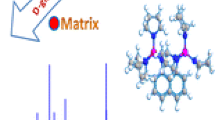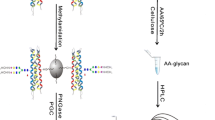Abstract
Sensitive analysis of oligosaccharides by matrix-assisted laser desorption/ionization time-of-flight mass spectrometry (MALDI-TOF MS) is significantly hampered by the low ionization efficiency of oligosaccharides. Derivatization affords a feasible way to enhance the MALDI intensities of oligosaccharides by introducing an easily ionized and/or hydrophobic tag to their reducing ends. However, tagging and subsequent desalting processes are quite time-consuming. Herein, we develop a rapid and sensitive approach for oligosaccharide derivatization by using 2-hydrazinopyrimidine (2-HPM). As a result of the presence of an electron-withdrawing N-heterocycle, 2-HPM can quantitatively derivatize oligosaccharides within 15 min and selectively facilitate their ionization. Additionally, 2-HPM acts as co-matrix to enhance the MALDI signal of oligosaccharides, and therefore the tedious enrichment and purification processes prior to MALDI analysis are avoided. This approach is applied to the analysis of various oligosaccharides released from glycopeptides, glycoprotein, and biological samples. After derivatization, a significant increase of MALDI intensities (greater than 10-fold) was observed for all the tested neutral and sialylated oligosaccharides. Moreover, the enhanced fragmentation of MS/MS brings much convenience to the structural elucidation of oligosaccharides.

Improved MALDI MS analysis of oligosaccharides by using 2-hydrazinopyrimidine as a derivative tag and co-matrix








Similar content being viewed by others
References
Arnold JN, Wormald MR, Sim RB, Rudd PM, Dwek RA. The impact of glycosylation on the biological function and structure of human immunoglobulins. Annu Rev Immunol. 2007;25:21–50.
Jiang K, Gao Y, Hou W, et al. Proteomic analysis of O-GlcNAcylated proteins in invasive ductal breast carcinomas with and without lymph node metastasis. Amino Acids. 2016;48(2):365–74.
Moremen KW, Tiemeyer M, Nairn AV. Vertebrate protein glycosylation: diversity, synthesis and function. Nat Rev Mol Cell Biol. 2012;13(7):448–62.
Dalziel M, Crispin M, Scanlan CN, Zitzmann N, Dwek RA. Emerging principles for the therapeutic exploitation of glycosylation. Science. 2014;343(6166):1235681.
Kaufmann R. Matrix-assisted laser desorption ionization (MALDI) mass spectrometry: a novel analytical tool in molecular biology and biotechnology. J Biotechnol. 1995;41(2):155–75.
Zhao Y, Kent SB, Chait BT. Rapid, sensitive structure analysis of oligosaccharides. Proc Natl Acad Sci. 1997;94(5):1629–33.
Zaia J. Mass spectrometry of oligosaccharides. Mass Spectrom Rev. 2004;23(3):161–227.
Mechref Y, Hu Y, Desantos-Garcia JL, Hussein A, Tang H. Quantitative glycomics strategies. Mol Cell Proteomics. 2013;12(4):874–84.
Xia B, Kawar ZS, Ju T, Alvarez RA, Sachdev GP, Cummings RD. Versatile fluorescent derivatization of glycans for glycomic analysis. Nat Methods. 2005;2(11):845–50.
Jiang K, Wang C, Sun Y, et al. Comparison of chicken and pheasant ovotransferrin N-glycoforms via electrospray ionization mass spectrometry and liquid chromatography coupled with mass spectrometry. J Agric Food Chem. 2014;62(29):7245–54.
Pabst M, Kolarich D, Pöltl G, et al. Comparison of fluorescent labels for oligosaccharides and introduction of a new postlabeling purification method. Anal Biochem. 2009;384(2):263–73.
Rohmer M, Meyer B, Mank M, Stahl B, Bahr U, Karas M. 3-Aminoquinoline acting as matrix and derivatizing agent for MALDI MS analysis of oligosaccharides. Anal Chem. 2010;82(9):3719–26.
Lattova E, Perreault H. Profiling of N-linked oligosaccharides using phenylhydrazine derivatization and mass spectrometry. J Chromatogr A. 2003;1016(1):71–87.
Snovida SI, Chen VC, Perreault H. Use of a 2,5-dihydroxybenzoic acid/aniline MALDI matrix for improved detection and on-target derivatization of glycans: a preliminary report. Anal Chem. 2006;78(24):8561–8.
Cai Y, Zhang Y, Yang P, Lu H. Improved analysis of oligosaccharides for matrix-assisted laser desorption/ionization time-of-flight mass spectrometry using aminopyrazine as a derivatization reagent and a co-matrix. Analyst. 2013;138(21):6270–6.
Jiao J, Zhang Y, Yang P, Lu H. Hydrazinonicotinic acid as a novel matrix for highly sensitive and selective MALDI-MS analysis of oligosaccharides. Analyst. 2015;140(1):156–61.
Kaneshiro K, Fukuyama Y, Iwamoto S, Sekiya S, Tanaka K. Highly sensitive MALDI analyses of glycans by a new aminoquinoline-labeling method using 3-aminoquinoline/α-cyano-4-hydroxycinnamic acid liquid matrix. Anal Chem. 2011;83(10):3663–7.
Breslow R, McNelis E. Studies on model systems for thiamine action. Synthesis of reactive intermediates, and evidence on the function of the pyrimidine ring. J Am Chem Soc. 1959;81(12):3080–2.
Wang H, Wang H, Zhang L, Zhang J, Guo Y. N-Alkylpyridinium isotope quaternization for matrix-assisted laser desorption/ionization Fourier transform mass spectrometric analysis of cholesterol and fatty alcohols in human hair. Anal Chim Acta. 2011;690(1):1–9.
Zou Y, Wu Z, Chen L, et al. An efficient approach for large-scale production of sialyglycopeptides from egg yolks. J Carbohydr Chem. 2012;31(4-6):436–46.
Ceroni A, Maass K, Geyer H, Geyer R, Dell A, Haslam SM. GlycoWorkbench: a tool for the computer-assisted annotation of mass spectra of glycans. J Proteome Res. 2008;7(4):1650–9.
Wang C, Yuan J, Li X, Wang Z, Huang L. Sulfonyl hydrazine-functionalized polymer as a specific capturer of reducing glycans from complex samples for high-throughput analysis by electrospray ionization mass spectrometry. Analyst. 2013;138(18):5344–56.
Yang SJ, Zhang H. Glycan analysis by reversible reaction to hydrazide beads and mass spectrometry. Anal Chem. 2012;84(5):2232–8.
Walker SH, Budhathoki-Uprety J, Novak BM, Muddiman DC. Stable-isotope labeled hydrophobic hydrazide reagents for the relative quantification of N-linked glycans by electrospray ionization mass spectrometry. Anal Chem. 2011;83(17):6738–45.
Bigge J, Patel T, Bruce J, Goulding P, Charles S, Parekh R. Nonselective and efficient fluorescent labeling of glycans using 2-amino benzamide and anthranilic acid. Anal Biochem. 1995;230(2):229–38.
Reiding KR, Blank D, Kuijper DM, Deelder AM, Wuhrer M. High-throughput profiling of protein N-glycosylation by MALDI-TOF-MS employing linkage-specific sialic acid esterification. Anal Chem. 2014;86(12):5784–93.
Stumpo KA, Reinhold VN. The N-glycome of human plasma. J Proteome Res. 2010;9(9):4823–30.
Varki A. Glycan-based interactions involving vertebrate sialic-acid-recognizing proteins. Nature. 2007;446(7139):1023–9.
Song X, Yu H, Chen X, et al. A sialylated glycan microarray reveals novel interactions of modified sialic acids with proteins and viruses. J Biol Chem. 2011;286(36):31610–22.
Sekiya S, Wada Y, Tanaka K. Derivatization for stabilizing sialic acids in MALDI-MS. Anal Chem. 2005;77(15):4962–8.
Raman R, Raguram S, Venkataraman G, Paulson JC, Sasisekharan R. Glycomics: an integrated systems approach to structure-function relationships of glycans. Nat Methods. 2005;2(11):817–24.
Tang H, Mechref Y, Novotny MV. Automated interpretation of MS/MS spectra of oligosaccharides. Bioinformatics. 2005;21 Suppl 1:i431–9.
Amano J, Sugahara D, Osumi K, Tanaka K. Negative-ion MALDI-QIT-TOFMSn for structural determination of fucosylated and sialylated oligosaccharides labeled with a pyrene derivative. Glycobiology. 2009;19(6):592–600.
Domon B, Costello CE. A systematic nomenclature for carbohydrate fragmentations in FAB-MS/MS spectra of glycoconjugates. Glycoconj J. 1988;5(4):397–409.
Acknowledgments
We sincerely thank Georgia Research Alliance (GRA) and Georgia State University for purchasing the analytical instrument used in this research. This work was financially supported by the National Basic Research Program of China (973 Program, grant no. 2012CB910303), National Natural Science Foundation of China (31470795), Tianjin Municipal Science and Technology Commission (15JCYBJC24100) and China Scholarship Council (201506200006).
Author information
Authors and Affiliations
Corresponding authors
Ethics declarations
Conflict of interest
The authors declare that they have no conflict of interests.
Informed consent
Informed consent was obtained from all individual participants included in the study.
Additional information
Published in the topical collection Glycomics, Glycoproteomics and Allied Topics with guest editors Yehia Mechref and David Muddiman.
Electronic supplementary material
Below is the link to the electronic supplementary material.
ESM 1
(PDF 721 kb)
Rights and permissions
About this article
Cite this article
Jiang, K., Aloor, A., Qu, J. et al. Rapid and sensitive MALDI MS analysis of oligosaccharides by using 2-hydrazinopyrimidine as a derivative reagent and co-matrix. Anal Bioanal Chem 409, 421–429 (2017). https://doi.org/10.1007/s00216-016-9690-x
Received:
Revised:
Accepted:
Published:
Issue Date:
DOI: https://doi.org/10.1007/s00216-016-9690-x




